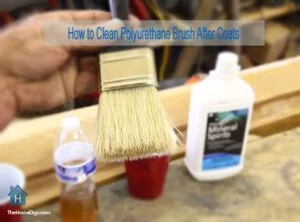
Wooden surfaces often need stains, paints, and coats to stay better. Polyurethane is basically a clear top coating and it is often used over the wood surface or paint. It’s a “complex to work with” substance that is also thick consistency.
And that’s why you’ll find the application of polyurethane more effort demanding than paint. One part of the complication involves removing polyurethane from applicator or brush that you were using.
Using the instinctual approach, you cannot get a good cleanup here. And so, to clean polyurethane from a brush, there are a few matters you should be aware of. Today let’s talk in-depth about how to clean polyurethane brush and the right way to store it in-between each coating.
How to Clean a Brush After Polyurethane Coating
First of all, there are two types or forms of polyurethane that people use often. Depending on what type you just used to coat, you’ll need to go for a specific manner for cleaning it. Here we are going to talk about both the water-based as well as oil-based polyurethane.
Cleaning Water-Based Polyurethane
To clean foam brush after polyurethane application, you are going to start with flushing it thoroughly with clean water. Make sure you flush it well until water removes most of the water-based polyurethane from brush. Now after that, you need to make the brush dry completely. Or you can simply store the brush inside a jar that is full of water. So that it can soak for a little time and the remaining substance comes out.
Just keep in mind that the soaking period should not be too lengthy. Because standing brush in a liquid, for too long, can threaten the durability of that applicator. It often results in distorting the bristle of your applicator brush. And so, you may find it wearing out sooner.
Cleaning Oil-Based Polyurethane
In the case of oil-based polyurethane, just water won’t be enough. You will need to involve some chemicals here. For brushes that have dried out too hard, you will need to use paint thinner or white spirit. Since these are pretty strong to get rid of the dried polyurethane. However, before that, the brush needs some good soaking period as well as a massaging session. This will further soften the polyurethane. Once you are done, use some acetone after paint thinner. This will help to get rid of the thinner from brush. Finally, you need to wash polyurethane brush using soap and water. This will get rid of the acetone remaining.
The soap will play as a softener for bristle of brush. So that the next time you use brush, it feels more flexible as well as soft. With good quality brushes, you should not skip this process even if it feels extended. This will ensure the brush to work for another good many years.
Don’t Let All Your Cleaning Go in Vain
Once you clean a brush used for polyurethane, the next thing to care seriously about is storing it right way. Sometimes because of poor storing habits, all your cleaning goes completely in vain. It’s important to store the brush inside a cardboard package if possible. This will ensure longevity and proper maintenance to keep the brush working for next many years.
————————–
Read Also: Best Cleaner for Laminate and Hardwood Floor
How to Use Bona Hardwood Floor Cleaner
Best Wood Filler for Hardwood Floors
————————–
How to Store Polyurethane Brush Between Coats
Sometimes we tend to pause for a day or maybe a few hours while a coating or painting process. When you do that with a polyurethane application, there’s a good chance of your brush drying out hard. And that’s definitely not good news for the next application sessions.
Also, this is pretty damaging for the brush. The polyurethane will start to harden when it stays in air exposure for a long time. And so, there are a few things you need to do in-between coats to keep polyurethane brush from drying out
Try to keep the bristles of brush at least one-third part dipped into liquid before you leave for break. So that it does not face hardening until you come back and continue your application process. This is when you are thinking for a short break to eat or simply get some rest.
If you are leaving the session for a pretty long break then there’s more to do. You may think of using some plastic wrap as its one common conventional way to go for. Simply wrapping the brush around plastic will do nothing. In fact, when you return, you’ll notice the brush has dried and got stuck with plastic making it even worse.
Instead of plastic wrap, try to use an aluminum foil. It’s by far the easiest and simplest solution that actually works to keep brush away from drying out. Simply wrap the brush while ensuring bristles are well covered with aluminum. Then cut off any excess portions of foil that you don’t need to use and that’s it.
Conclusion
Whether you are using the polyurethane floor finish or simply for any other need, keeping brushes and applicators clean is very important. The cleaning phase is definitely tricky but with a little guidance, it’s not that hard also. Water-based poly will need less effort. However, in the case of oil-based poly, you want to ensure some good chemical involvement that isn’t harsh also.
Now that you have a broad idea of how to clean polyurethane brush, go ahead and give your brushes a good clean-up.
This is Autem Decker. Main Author of ‘TheHomeDigs‘. You may not find her on the list of top 10 contemporary Canadian interior designers, but everyone who knows her says she was born to be an interior designer.
She makes her plan in her head and draws them in her years-old diary with a note in the corner. The way she plays with color and shape amazes us.
Connect Her On – Twitter